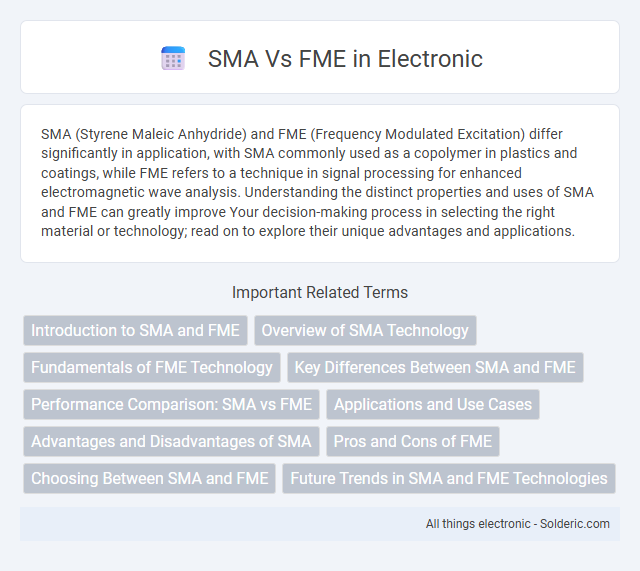SMA (Styrene Maleic Anhydride) and FME (Frequency Modulated Excitation) differ significantly in application, with SMA commonly used as a copolymer in plastics and coatings, while FME refers to a technique in signal processing for enhanced electromagnetic wave analysis. Understanding the distinct properties and uses of SMA and FME can greatly improve Your decision-making process in selecting the right material or technology; read on to explore their unique advantages and applications.
Comparison Table
| Feature | SMA (Sheet Molding Compound) | FME (Fiber Metal Laminate) |
|---|---|---|
| Material Composition | Thermoset resin with glass or carbon fibers | Alternating layers of metal and composite fibers |
| Weight | Lightweight, ideal for weight reduction | Lightweight, but typically heavier than SMA |
| Strength | High tensile strength, impact resistant | High strength-to-weight ratio with enhanced fatigue resistance |
| Corrosion Resistance | Excellent, non-metallic matrix | Good, but metal layers need protection |
| Manufacturing Process | Molded under heat and pressure, fast cycle time | Layup and bonding of metal and fiber layers, more complex |
| Applications | Automotive parts, electrical housings, aerospace panels | Aerospace skins, military armor, high-performance structures |
| Cost | Moderate, cost-effective for mass production | Higher, due to complex fabrication and materials |
Introduction to SMA and FME
Surface-Mounted Antenna (SMA) and Fiber Management Enclosure (FME) serve distinct roles in communication and network infrastructure. SMA connectors are precision RF connectors used for microwave frequency signals, offering reliable performance in wireless systems and instrumentation. FME devices organize and protect fiber optic cables, ensuring efficient network management and minimizing signal loss in telecommunications environments.
Overview of SMA Technology
SMA (Shape Memory Alloy) technology utilizes materials that return to their original shape after deformation when exposed to heat or electrical stimuli, making them ideal for precise actuators and sensors. Unlike traditional FME (Flexible Metallic Elements), SMA components offer superior recovery strain and adaptability in compact applications. Your designs benefit from SMA's unique thermomechanical properties, enabling innovative solutions in robotics, aerospace, and medical devices.
Fundamentals of FME Technology
FME (Feature Manipulation Engine) technology specializes in spatial data integration by enabling seamless extraction, transformation, and loading (ETL) of geospatial and non-geospatial data across diverse formats. Unlike SMA (Spatial Map Analysis), which primarily focuses on spatial pattern recognition and analysis, FME provides robust automation capabilities for data validation, conversion, and workflow optimization. Your data management processes benefit from FME's extensive format support and its ability to streamline complex GIS and IT system integrations.
Key Differences Between SMA and FME
SMA (Surface Mount Assembly) and FME (Field Maintenance Engineering) differ primarily in their roles within electronics manufacturing and maintenance. SMA involves the precise placement and soldering of surface mount components onto circuit boards during production, ensuring product reliability and quality. FME focuses on diagnosing, repairing, and maintaining electronic systems in the field, emphasizing troubleshooting skills and on-site service to keep equipment operational.
Performance Comparison: SMA vs FME
SMA (Shape Memory Alloy) and FME (Flexible Manufacturing Equipment) differ significantly in performance metrics, with SMA offering rapid response times and high durability in dynamic environments, while FME excels in adaptability and precision for complex manufacturing tasks. SMA's actuation speed and fatigue resistance make it suitable for applications requiring repetitive and consistent motion, whereas FME provides scalable automation solutions that enhance operational efficiency and customization. Your choice between SMA and FME should consider the specific performance demands, such as speed, flexibility, and endurance, to optimize system functionality.
Applications and Use Cases
SMA (Shape Memory Alloy) is widely used in medical devices, robotics, and aerospace for actuation and adaptive structures, leveraging its ability to return to a pre-defined shape under temperature changes. FME (Functional Mock-up Environment) excels in systems engineering and simulation, enabling the integration of diverse models for automotive, energy, and manufacturing sectors to optimize complex system performance. Your choice between SMA and FME depends on whether you need physical material actuation or comprehensive system-level simulation and integration.
Advantages and Disadvantages of SMA
Shape Memory Alloys (SMA) offer significant advantages such as high actuation strain, excellent fatigue resistance, and the ability to recover large deformations without permanent damage, making them ideal for applications requiring compact and lightweight actuators. However, SMAs exhibit slower response times and higher energy consumption compared to traditional electromechanical actuators like Flexible Mechanical Elements (FME), and their performance can be limited by temperature sensitivity and hysteresis effects. Despite these drawbacks, SMAs provide superior noise reduction and increased design flexibility in medical devices, aerospace systems, and robotics where precise and smooth motion control is essential.
Pros and Cons of FME
FME (Feature Manipulation Engine) excels in complex spatial data transformation and integration, supporting over 450 formats, which enhances interoperability in GIS workflows. Its user-friendly interface and automation capabilities streamline data processing but come with a steep learning curve and higher licensing costs compared to SMA (Spatial Modeling Architecture). FME's flexibility and robust support justify the investment for organizations handling diverse geospatial datasets, while smaller teams may find SMA more cost-effective and easier to implement.
Choosing Between SMA and FME
Choosing between SMA (Surface-Mount Assembly) and FME (Field-Mount Equipment) depends on your project's specific requirements for durability, installation environment, and maintenance accessibility. SMA offers compact, efficient designs ideal for controlled environments with precise placement, while FME provides rugged, flexible solutions suitable for harsh outdoor or industrial conditions. Assess your operational needs and environmental constraints carefully to determine which technology aligns best with your performance and longevity goals.
Future Trends in SMA and FME Technologies
Future trends in Shape Memory Alloys (SMA) emphasize advancements in nanoscale engineering and multi-functional applications, improving responsiveness and durability for biomedical and aerospace uses. Fusion Melting Equipment (FME) technology is evolving with enhanced automation and energy efficiency, facilitating precise control in metal casting and additive manufacturing processes. Integration of smart sensors and machine learning algorithms is driving innovation in both SMA and FME, optimizing performance and predictive maintenance.
SMA vs FME Infographic

 solderic.com
solderic.com